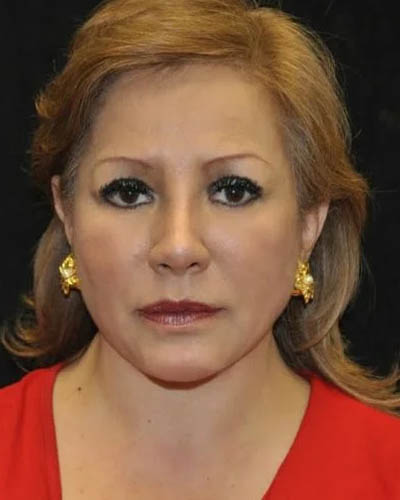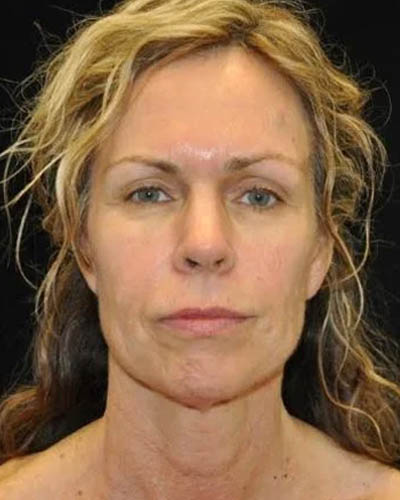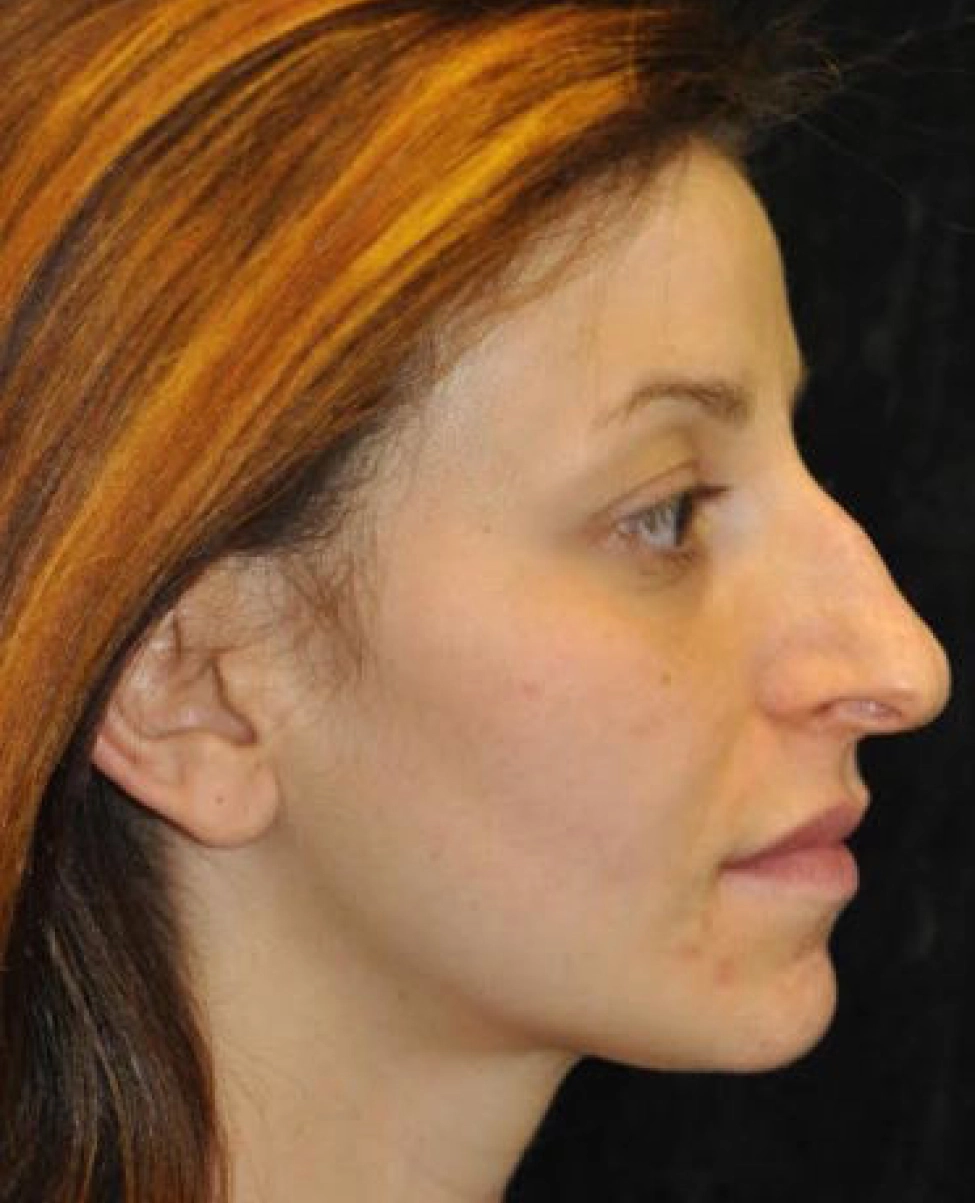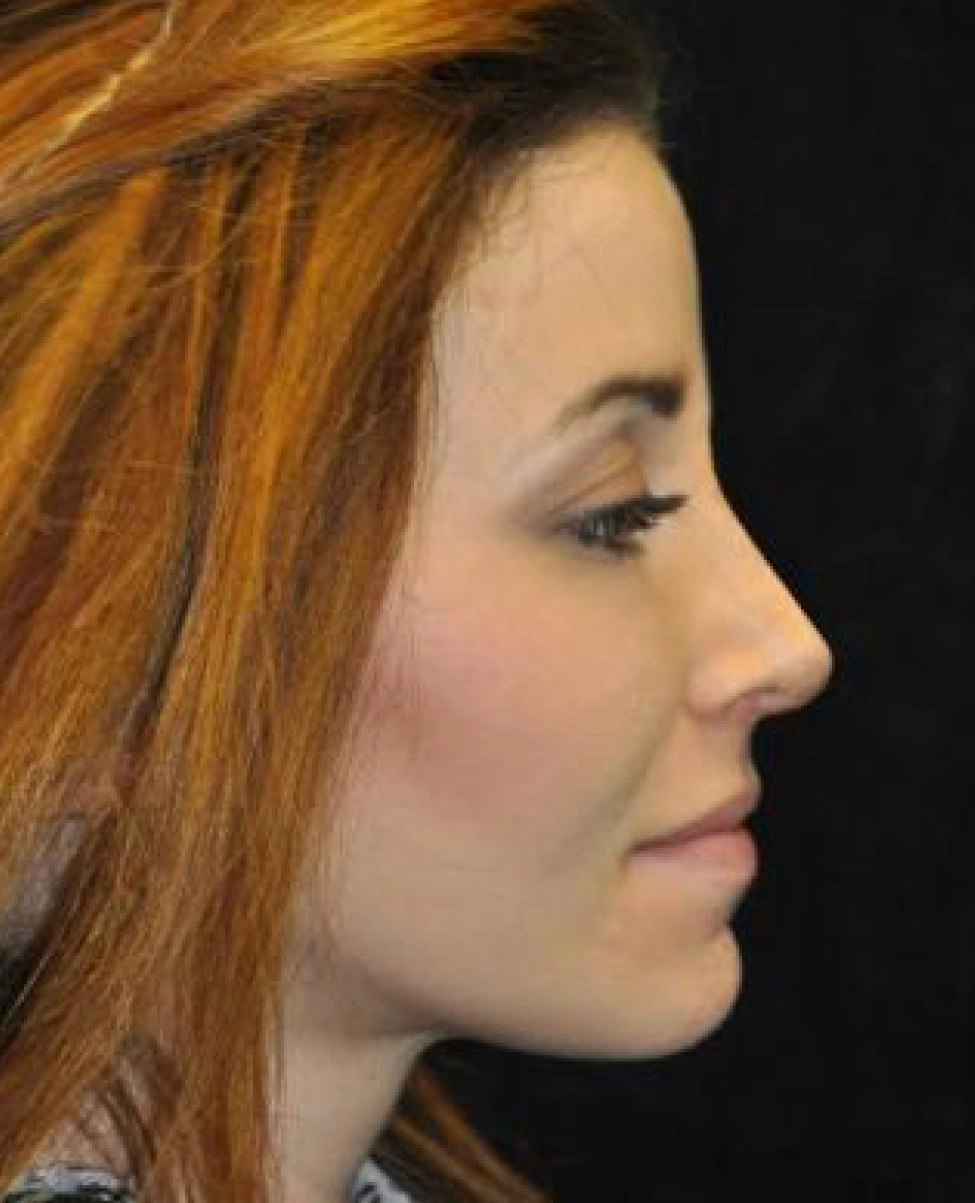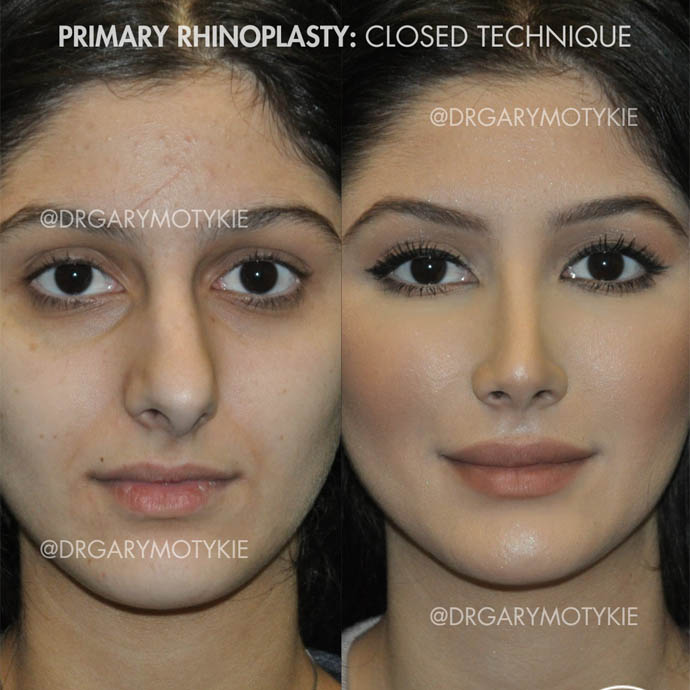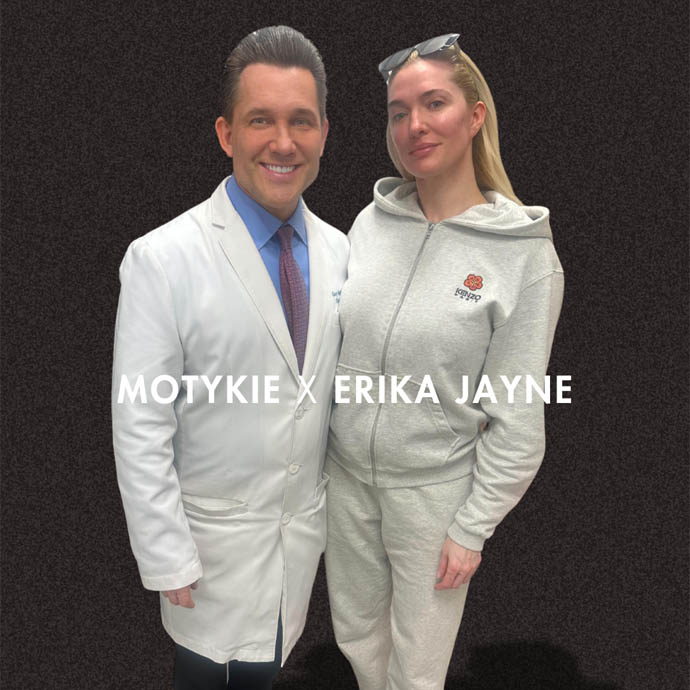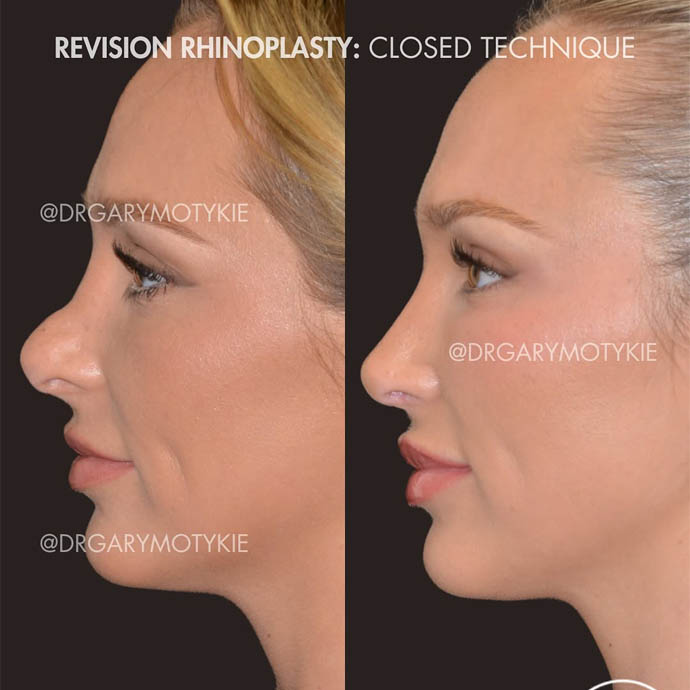- Face
- Breast
- Body
- Motykie Med Spa
- Injectables
- Skin
- Celluma Led Light Therapy
- Chemical Peels
- Hydrafacial
- IPL Photofacial
- Laser Hair Removal
- Laser Skin Resurfacing (Laser Genesis)
- Medical Grade Facials
- Morpheus8
- Microneedling
- PRFM / PRP (EZ Gel)
- RF BTL Exilis
- Spider Veins & Vascular Leisons+ (ExcelV)
- Sun & Brown Spot Removal
- Stem Cell Facelift
- Thread Lifts
- Anti-Aging
- Hair
- About
- Surgery Suite
- Locations
- Gallery
- Resources
- Media
- Consultation
 Are you considering enhancing your facial balance through rhinoplasty? This cosmetic procedure, commonly referred to as a nose job, can greatly improve the overall harmony and symmetry of your face. Whether you are looking to address a specific issue with your nose or simply desire a more aesthetically pleasing profile, rhinoplasty could be the solution you’ve been searching for. Board-certified plastic surgeon Dr. Gary Motykie performs rhinoplasty for patients in Beverly Hills, West Hollywood, Los Angeles, and surrounding locations.
Are you considering enhancing your facial balance through rhinoplasty? This cosmetic procedure, commonly referred to as a nose job, can greatly improve the overall harmony and symmetry of your face. Whether you are looking to address a specific issue with your nose or simply desire a more aesthetically pleasing profile, rhinoplasty could be the solution you’ve been searching for. Board-certified plastic surgeon Dr. Gary Motykie performs rhinoplasty for patients in Beverly Hills, West Hollywood, Los Angeles, and surrounding locations.
Understanding Facial Balance and Symmetry
Facial balance and symmetry are foundational concepts in the realm of aesthetic beauty, holding a paramount position in the determination of attractiveness. The human eye naturally seeks out symmetry and proportion, making these elements critical in the perception of facial aesthetics. The importance of balance cannot be overstated, as it influences how individual facial features are viewed in relation to one another and to the face as a whole. A well-balanced face, where features are in harmonious proportion, is often considered more beautiful and appealing.
At the heart of facial balance lies the nose, given its central location and its role as a focal point. It acts almost as an anchor, drawing together the various elements of the face into a cohesive unit. The size, shape, and position of the nose can dramatically affect the perception of other facial features, such as the eyes, cheeks, and mouth. For instance, a nose that is perceived as too large or too small can distort the sense of proportion, making other features appear more prominent or diminished than they actually are.
The principles of facial symmetry further elaborate on the need for equal or nearly equal visual weight on either side of the face. Perfect symmetry is rare in nature, and a slight asymmetry is normal and can add to the uniqueness and charm of an individual’s appearance. However, significant deviations from symmetry can distract the eye and disrupt the natural flow of one’s facial features. This is where rhinoplasty can play a crucial role, by correcting asymmetrical issues that detract from the overall harmony of the face.
Rhinoplasty, with its ability to alter the size, shape, and position of the nose, serves as a powerful tool in enhancing facial balance and symmetry. It is not merely about making a nose smaller or reshaping the nostrils; it is about creating a nose that fits seamlessly with the rest of the facial features, enhancing the natural beauty and balance of the face. This delicate balancing act requires a thorough understanding of facial anatomy and aesthetics, as well as a keen artistic eye, to ensure that the changes made during a rhinoplasty procedure enhance facial harmony rather than detract from it.
Understanding the intricacies of facial balance and symmetry is crucial for anyone considering rhinoplasty. It goes beyond a superficial desire for a “better-looking” nose, encompassing a deeper understanding of how the nose contributes to the overall aesthetics of the face. A well-executed rhinoplasty can do more than just alter the shape of the nose; it can enhance the entire facial structure, bringing it into a more harmonious and balanced state. This, in turn, can have a profound impact on one’s appearance and self-perception, highlighting the transformative power of rhinoplasty when approached with an eye for balance and symmetry.
The Rhinoplasty Procedure Explained
Rhinoplasty, often envisioned as one of the most transformative cosmetic surgeries, is tailored to reshape the nose’s structure, enhancing facial symmetry and balance. The intricacies of the procedure are paramount, encompassing meticulous adjustments to bone, cartilage, and soft tissues, aiming for an outcome that harmonizes with the individual’s facial aesthetics. The surgical journey begins with a detailed consultation, where the surgeon delineates the procedure tailored to the specific needs and aesthetic goals of the patient.
During the actual surgical process, precision and artistry are at the forefront. The approach taken—whether open or closed rhinoplasty—depends largely on the complexity of the desired changes and the surgeon’s expertise. In an open rhinoplasty, a small incision is made across the columella, the thin strip of tissue separating the nostrils, allowing the surgeon comprehensive access to the nasal structure. This approach is often reserved for more extensive reshaping. The closed technique, on the other hand, involves incisions hidden within the nostrils, resulting in no visible scarring and is typically employed for less complex modifications.
Irrespective of the approach, the surgeon delicately alters the nasal architecture. This may involve sculpting the nasal bones and cartilage to remove a bump on the bridge, narrowing the width of the nose, or refining the nasal tip’s shape. For those with functional concerns, such as a deviated septum that impedes breathing, adjustments are made to rectify these issues, merging aesthetic enhancements with functional improvements.
The materials used to support and shape the nose during rhinoplasty also play a critical role. In some cases, additional structural support is required, which may involve the use of grafts taken from elsewhere in the patient’s body, such as the ear or rib, or the use of synthetic materials. These grafts are used to reinforce the nasal structure or to create a more desirable shape.
Post-surgery, the transformation begins to reveal itself as swelling and bruising subside. The recovery period is a crucial phase where the newly sculpted nasal contours gradually refine and settle into their permanent shape. Patients are guided through this process with detailed aftercare instructions, ensuring a smooth transition towards realizing the full potential of their rhinoplasty results.
Rhinoplasty’s ability to profoundly alter the nose’s appearance—making it larger or smaller, changing its angle in relation to the upper lip, or modifying the tip or bridge—offers a pathway to enhanced self-confidence and satisfaction with one’s appearance. However, it’s the meticulous planning, surgical skill, and post-operative care that truly define the success of the procedure.
As patients embark on this transformative journey, they are encouraged to maintain open communication with their surgeon, ensuring their vision for aesthetic enhancement aligns with the possibilities of surgical artistry. This collaborative approach helps in sculpting not just a more pleasing nasal appearance but a refined, balanced facial aesthetic that resonates with the individual’s identity and aspirations.
Customizing Your Rhinoplasty for Optimal Results
Rhinoplasty stands out as one of the most personalized cosmetic surgeries available, offering an unparalleled opportunity to refine and redefine one’s facial aesthetics. The procedure’s unique capability to tailor outcomes to each person’s distinctive features and aesthetic aspirations is at the core of its transformative power. During the initial stages of planning, the surgeon-client collaboration is instrumental in sculpting a vision that aligns with the individual’s desires and the realistic possibilities of surgical intervention.
The journey to customizing your rhinoplasty begins with a comprehensive consultation. This crucial first step allows for an in-depth discussion of your aesthetic goals, medical history, and any concerns you may have. It is during this time that the surgeon evaluates your facial structure, taking into account the proportion, symmetry, and overall balance of your features. Understanding the integral role the nose plays in facial harmony, the surgeon assesses how modifications to its size, shape, or position could enhance your facial aesthetics.
Modern technology plays a pivotal role in the customization process. Advanced computer imaging software has become an invaluable tool, enabling you and your surgeon to visualize potential outcomes. This digital simulation serves as a powerful communication aid, fostering a mutual understanding and refining the surgical plan to ensure your expectations are both clear and achievable.
The customization extends beyond aesthetic considerations, encompassing functional aspects as well. For individuals facing breathing difficulties due to structural abnormalities, such as a deviated septum, rhinoplasty offers a dual benefit. By addressing these issues, the procedure not only improves nasal function but also contributes to the overall aesthetic result, underscoring the holistic approach taken in customized rhinoplasty planning.
Choice of surgical technique further customizes the procedure to fit your specific needs. Surgeons decide between open and closed rhinoplasty techniques based on the complexity of the changes required and your unique anatomy. Each approach has its advantages, with the decision ultimately guided by the goal of achieving the best possible aesthetic and functional outcome.
The customization process also considers the materials used during the procedure. For some, the structure of their nose may require additional support, which can be provided through grafts sourced from the patient’s own body or through synthetic alternatives. The choice of material is determined by a variety of factors, including the desired outcome, the structural needs of the nose, and the surgeon’s expertise.
Post-operative care is tailored to support a smooth recovery and optimal healing, with instructions and follow-up plans adjusted to each patient’s procedure and personal circumstances. This individualized approach ensures that each patient receives the care and support needed to achieve the best results.
Customizing your rhinoplasty involves a deep understanding of your aspirations, a thorough assessment of your facial features, and a clear communication pathway with your surgeon. This personalized approach not only maximizes the aesthetic and functional outcomes of the procedure but also aligns with your identity and personal vision of beauty. Through meticulous planning and skilled execution, rhinoplasty can dramatically enhance facial balance and symmetry, reflecting your unique beauty and boosting your confidence in your appearance.
Contact Beverly Hills Board Certified Plastic Surgeon Dr. Gary Motykie to Schedule a Consultation
Click Here for Virtual Consultation
Click Here to Schedule a In Office Consultation
To see more services and treatments provided by Board Certified Plastic Surgeon, Dr. Motykie in Beverly Hills | Los Angeles | West Hollywood, CA and his team please visit:

